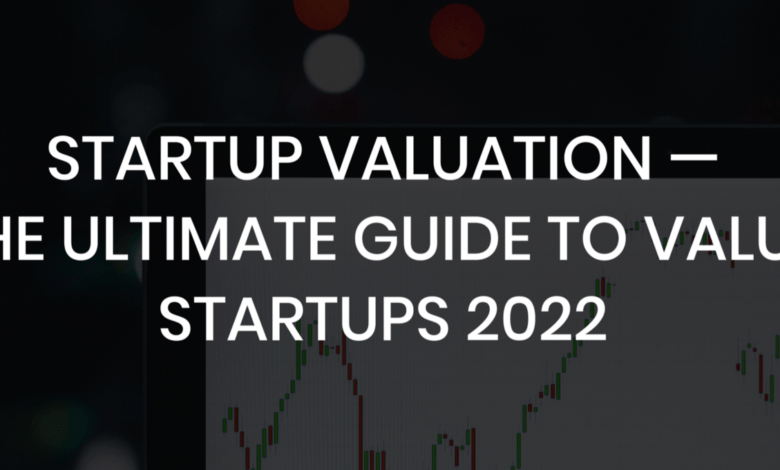Startup valuation : How to value your startup being an early-stage investor, 10 techniques, what mistakes to be avoided

How to value your startup being an early-stage investor, 10 techniques, what mistakes to be avoided
Startup valuations show a company’s ability to use the new capital to expand, meet customer and investor expectations, and achieve the next aim. Unicorn values, or companies worth $1 billion or more, now number in the hundreds. There are now “decacorns,” or businesses worth $10 billion or more, and “hectocorns,” or companies worth more than $100 billion.
These computations, while remarkable, aren’t really objective . A startup valuation may take into Account your team’s experience, product, Assets, business model, total addressable market, competition performance, market potential, goodwill, and other criteria.
You can use concrete economic figures being a Initial Point if you have real incomes. However, when it comes to Financing, your firm is only worth what you and your investors agree it is. Most angel investors and Venture Capital companies employ several Methods to determine a company’s pre-money value or how much it is worth before they made the investments.
It’s fair to argue that evaluating a startup is a science and an art. It will help you understand the several company Valuation methods, either you’re in the pre-seed stage or merely giving stock options to your staff. We’ll go through eight ways to value your firm and prepare for future fundraising conversations in this post.
Pre-revenue startup valuation is a problematic Task. There are other factors to evaluate, including the management team and industry trends and product demand, and marketing hazards.

Here’s the kicker:
Even with the most successful pre-money valuation procedures, the most you can expect is only an estimate after assessing everything.
It’s critical to remember this.
So, with that in mind, let’s dig in and look at some of the most prevalent methods for valuing a business with no income.
THE DISTINCTION BETWEEN STARTUP AND SMALL BUSINESS VALUATION
First off, let’s explain the basics.
What is the definition of startup valuation?
Determining the worth of a new firm is known by the term startup valuation. Startup valuation methods are especially relevant since they are often used to value startups that are still in the early stages of development.
Business owners will want a high valuation, but pre-revenue investors will want a lower price that ensures a higher return on investment (ROI).
A startup valuation calculates how much a business is worth in the market, depending on several factors. Valuing your company is a process that a business must undergo when raising Financing or looking for a technical cofounder, a business cofounder, or another partner or shareholder.
It’s important to establish a fair Valuation for your company because no investors and co founders will be willing to put money into it if it’s overvalued. Undervaluing your startup, on the other hand, means that you’re ready to give up an important amount of stock in return for a lesser number of money or that you’re undervaluing what you’ve already done.
The value of a company is mainly influenced by its stage and either or not it has received outside funding. The valuation of a company often changes when it achieves a specific milestone.
What is the difference between a pre-revenue startup valuation and a mature firm valuation?
Unlike an early-stage startup, a mature publicly-listed company would have more facts and numbers to work on. It is easier to determine the worth of a firm when there is a constant source of revenue and Financial Records.
This is often done using the EBITDA calculation, which determines a company’s value based on profits before interest, taxes, depreciation, and amortization.
EBITDA = Net Profit + Interest + Taxes + Depreciation + Amortization
Because you won’t have these statistics on hand, assigning a valuation to a fledgling firm with no sales probably be difficult.
While most startup Valuation Methodologies don’t include information on earnings, taxes, or amortization, you will be able to Factor in other important elements.
FACTORS TO CONSIDER FOR PRE-REVENUE STARTUP VALUATION
Most of the time, early-stage companies are valued in the middle, which states that founders don’t make much like they thought, and investors spend more than they planned.
Let’s look at the most critical factors to take into Account when evaluating a company before generating revenue.
Traction is a display of a concept.
Traction is one of the most important factors to take into Account when evaluating how to value a company with no income. Look at the following to learn the actual story of the company:
Number of Users — Demonstrating that you already have Clients is critical. The higher the number, the better.
Marketing Effectiveness: Pre-revenue investors will be interested if you can show that you can gain high-Value customers for a low acquisition cost.
Growth Rate: Demonstrating that your firm has extended on a limited budget is benefits since many investors will see the chances for expansion if you have some funding.

These three elements are linked since a successful marketing strategy will result in immense growth. The number of users will soar being a result. As a result, you instantly add value to your startup by calculating that you have a strong, scalable business idea.
Investors begin to view their money being a gasoline source for the fire.
The Importance of a Founders’ Team
Pre-revenue investors want to know that they’re investing in a team that’s going to be successful. They’ll think about the following:
Proven Experience: A startup with founders who have before had success with other companies will be more tempting than one with immature beginners.
Abilities Diversity: A startup team should theoretically contain professionals with complementary skills. A smart coder cannot achieve everything on her alone, but when she joins forces with a Marketing Specialist, the startup becomes more valuable.
Commitment: Great entrepreneurs are one piece of the jigsaw. That personnel must be willing to put in the time and effort necessary to protect the startup’s success. A group of part-time employees will be unappealing.
Irrespective of the pre-money valuation approach, a prototype is a game-changer. Being able to show a working model of your product to pre-revenue investors illustrates your perseverance and vision for bringing ideas to life, but it speeds up the company’s launch.
You probably be able to get $500K to $1.5M in investment if you have a Minimum Viable Product (MVP) and some early consumers.
If your firm is examines using the valuation-by-stage technique, which many Venture Capitalists and angel investors use, a functional prototype probably fetch you even more money. A $2 million to $5 million investment probably be made due to this.
Demand and Supply
Your startup valuation will be influenced if you operate in a market where the number of business owners outnumbers the number of potential investors. Many business owners are anxious for investment in such a competitive environment and may even sell themselves short.
On the other hand, you have a unique patentable concept for a tech business that is causing a stir in the industry. This may raise investor demand, hence improving your company’s worth.
Hot Trends and Emerging Industries
Many investors will pay a premium for booming companies like artificial intelligence or mobile gaming. The internet era is rife with prospects that many regards in the form of “the next great thing,” so it may be worth more if your business is in the appropriate field.
High-Profit Margin
Investors aren’t interested in products with poor profit margins. On the other hand, a high-growth firm with good margins and excellent sales growth estimates may be able to command higher funding.
The main issues that founders face when it comes to pricing their businesses
Being at the first stages
There’s no easy way to value a business objectively at this stage. A startup that hasn’t made money yet or hasn’t gained any traction can’t be appreciated. As a result, if you consult two experts, each will provide you with a different estimate. Even most internet valuation systems may be readily abused by exaggerating the income.
Inability to objectively value a startup
Entrepreneurs who have put so much time and effort into their businesses are prone to overvaluing them. It’s known by the term the endowment effect, and it’s a psychological phenomenon. This will make things much more difficult because the valuation makes no sense to an angel investor!
What are the many approaches to valuing a startup?
Financial Analysts can employ a variety of startup valuation techniques. In the section below, we’ll go through some of the most prevalent tactics for evaluating companies. In the broadest sense, startups are new business companies created by an entrepreneur. They usually focus on developing new ideas or technologies and bringing them to market being new products or services.
In the broadest sense, startups are new business companies created by an entrepreneur.
INVESTORS CAN VALUE PRE-REVENUE COMPANIES IN 10 WAYS
Although performing a pre-revenue company valuation on your own may seem daunting, you may benefit from the experience and guidance of other entrepreneurs, angel investors, and Venture Capitalists.
Furthermore, by being familiar with the most usual startup valuation methodology, you’ll be able to not only evaluate a company with no income but to negotiate a better deal with pre-revenue investors.
Here are 10 tactics to consider:

-Berkus Approach
-Scorecard Valuation method
-Cost-To-Duplicate Approach
-Venture Capital (VC) Method
-Future Valuation Method
-Market Multiple Approach
-Risk Factor Summation Method
-Discounted Cash Flow (DCF) Method
-Combo Platter Method
-Asset-Based Valuation method (known by the term Book Value Valuation)
These are some of the methodologies used to evaluate the worth of a business.
The Berkus Approach
The Berkus Approach, devised by Dave Berkus, an American Venture Capitalist, and angel investor, focuses on evaluating a business based on a detailed evaluation of five important success factors:(1) Basic value, (2) Technology, (3) Execution, (4) Strategic partnerships in its main market, and (5) Production and subsequent sales are the five factors to consider.
In order to assess how much value the five main success criteria provide to the enterprise’s entire worth in quantitative terms, a detailed study is conducted. These numbers are used to determine the startup’s worth. The Berkus Approach is known by the term”the Stage Development Method” or “the Development Stage Valuation Approach.”
According to angel investor Dave Berkus, the company should be able to reach $20 million in five years. His method looks at five critical aspects of a startup:
Concept – The product provides fundamental value while posing a manageable risk.
Prototype — This lowers the risk of technology failure.
Quality assurance — If it isn’t already in place, the startup plans to hire a quality assurance staff.
Connections — There are already some strategic partnerships in place, which lessens competitive market threats.
There is evidence of a sales plan and product launch preparation. (Note that this does not apply to all companies at the pre-revenue stage.)
A grade of up to $500,000 is awarded to each facet, meaning a maximum value of $2.5 million.
The Berkus Method is a simple estimate approach used by software companies. It’s an excellent technique to estimate worth, but it lacks the flexibility that some people want because it doesn’t consider the market.
Scorecard Valuation method
This is one of the most common strategies used by angel investors to value startups. It’s also known as the Bill Payne valuation approach, and it compares your firm to others that have already received funding.
To begin, you must first calculate the typical pre-revenue company valuation in that market segment. According to Forbes, you can then analyze how the firm compares to others in the same region by looking at the following factors:
The management team’s strength (0–30 percent)
The worth of the founding team will vary majorly based on their background and experience. A 10% ownership in a new software business may be worth a nine-figure investment for Jeff Bezos or Mark Zuckerberg, yet your computer-illiterate friend Joe probably only be able to get a few hundred dollars for the same percentage.
The Size of the Opportunity (0–25%)
Market Size – Your pilot product may have some warm leads interested in it. The larger your prospective market, especially if you have ready-to-buy leads, the better.
Traction and Revenues Expected in the Short Term – Your valuation will be lower if you only have a few cold leads who aren’t ready to buy. The completed product will still be valuable, but theoretically, you’ll have enough traction with 50-100 clients for investors to see immediate income potential. It’s worth remembering that one possible buyer for a $50,000 product is riskier than ten potential consumers for a $5,000 product.
Product/Technology (between 0 and 15%)
(0–10%) in a competitive environment
Entering a market with a lot of high-level competition is a risk, and your valuation will suffer being a result. If you have a unicorn startup, you may claim an untapped market with no match and attract considerably more funding.
Channels of marketing/sales/partnerships (0–10 percent)
Growth and Engagement – You should be able to show that your user base is extending and that individuals are actively engaged. If you have an app, 100,000 infrequent users aren’t worth about 20,000 regular users. Also, if you want to attract investors, a declining user base is a warning indicator that must be addressed soon.
Additional investment (0–5%) is needed.
Other (between 0 and 5% of total)
Ranking these characteristics, like many other ways, is a very subjective procedure.
Keep in mind that scalability and team are the most important considerations.
“The quality of the staff is important to success in creating a business,” Payne says. Early product flaws will be rectified by a talented team, but the opposite is not valid.”
Venture Capital (VC) Method
The VC approach was popularized by Harvard Business School Professor Bill Sahlman.
The VC technique is a two-step procedure that necessitates the use of a number of pre-money valuation algorithms.
First, we determine the business’s terminal value in the harvest year.
Second, we determine the pre-money valuation by working backward from the predicted ROI and investment amount.
The year in which an investor leaves the company is known by the term the harvest year. The terminal value of a startup is its estimated value at some point in the future. The Industry P/E ratio, or stock price-to-earnings ratio, is another phrase you’ll need to grasp. For example, a P/E ratio of three indicates that the stock is worth three times its profits.
Determining the final value
The following figures are required:
-Estimated income during the harvest season
-Profit margin forecasted for the harvest year
-P/E ratio of the industry
By performing some web research, you may find industry averages for the P/E ratio and expected profit margins.
After you’ve gathered all of your information, do the following calculation:
Terminal Value = earnings * P/E, E.g., Terminal Value = anticipated sales * projected margin * P/E. In five years, a tech business expects to generate $10 million in revenue, with a 10% profit margin. The P/E ratio for the industry is 20.
As a consequence, the terminal value is $20 million, which is $10 million multiplied by 10% and multiplied by 20.
Pre-money valuation calculation
The following items are required for the second step:
Investment amount required return on investment (ROI)
Then perform the following calculation:
Terminal value / ROI – Investment amount = Pre-Money Valuation
Assume a $1 million investment from a pre-revenue investor is seeking a 10x return.
In this case, Pre-Money Valuation = $20M / 10 – $1M = $1M.
Using this method, we can estimate the present pre-revenue firm valuation to be $1 million. The company probably be worth $20 million in five years with a $1 million investment and proper growth and industry profit forecasts.
Cost-to-Duplicate Approach
Accounting for all starting and product development costs and expenses, which includes the purchase of physical Assets, is part of the Cost-to-Duplicate Approach. When determining the startup’s fair market value, all of these costs are factored together. The cost-to-duplicate strategy has the following disadvantages:
By running prediction statements of future sales and growth, the company’s future potential is not taken into Account.
In addition to its tangible Assets, it does not take into Account its intangible assets. The assumption is that the company’s intangibles, like brand value, goodwill, intellectual property rights (if any), and so on, may have a lot to provide for valuation even at this early stage.
The Future Valuation Multiple Approach
The Future Valuation Multiple Approach is only concerned with determining the return on investment that investors probably anticipate in the near future, say in the next five to ten years. Several forecasts, like five-year revenue projections, growth projections, cost and spending projections, and so on, are prepared for this purpose, and the startup is valued based on these future assumptions.
Market Multiple Approach
The Market Multiple Approach is one of the most widely used approaches for evaluating companies. The multiple market technique functions similarly to other multiples. The value of last market purchases of a comparable sort to the firm in issue is used to determine a base multiple. The market multiple is then used to determine the startup’s value.
Risk Factor Summation Approach
The Risk Factor Summation Approach assesses a business by evaluating all risks associated with it that probably affect its return on investment. Using the Risk Factor summation technique, an estimated beginning value for the startup may be calculated using one of the other ways discussed in this article. This starting value includes the impact of many types of business risks, both positive and negative, and an estimate is subtracted or added to the beginning value based on the risk’s impact.
After taking into Account all forms of risk and adding the “Risk Factor summation” to the Initial estimated value of the company, the ultimate worth of the company is determined. Some of the categories of business hazards covered include management risk, political risk, manufacturing risk, market competitiveness risk, investment and Capital Accumulation risk, technological risk, and legal environment risk.
To generate a more accurate improvement of an investment’s risks, this Technique merges components of the Scorecard Method with the Berkus Method. The following hazards are taken into Account:
-Management
-Stage of the company
-Capital/funding risk
-Manufacturing risks
-The risks of technology
-Risks in sales and marketing
-Threat of Competition
-Political risk/legislation
-Litigation risk
-International risks
-Risk to one’s reputation
-An exit strategy that probably be profitable
Each of these risk categories will be given a score based on the following criteria:
-2 (-$500,000) – extremely negative
-1 – a minus for extending the business and carryin gout a successful exit (-$250,000).
0 ($0) – neutral
(+$250,000) +1 – positive
+2 – excellent for scaling the business and carrying out a successful exit (+$500,000).
The pre-revenue company valuation will grow by $250,000 for every +1, and by $500,000 for every +2. For every -1, the pre-revenue value drops by $250,000, and for every -2, it drops by $500,000.
This approach is beneficial for determining the risks that must be addressed in order to fulfil a successful exit, and it may be used with the Scorecard Method to provide a thorough evaluation of the startup’s worth.
Discounted Cash Flow Approach
The Discounted Cash Flow (DCF) Method is used to expect a company’s Future Cash Flow movements. After that, the “Discount Rate,” or Rate of return on investment, is computed and used to estimate the predicted Cash Flow. Due to the Fact that startups are still in their infancy and investing in them is risky, a large discount Rate is usually used.
Combo Platter Method
Rich Palmer is the cofounder of Gravyty, a firm that boosts fundraising efforts through artificial intelligence (AI). When it came time for his business to approach pre-revenue investors, he and his team devised an Innovative Methodology that included features of several startup valuation approaches.
They established three categories of value based on their study into Angel List to have a better knowledge of comparable AI entities in Boston.
They then refined the estimates using the Berkus approach and the Risk Factor Summation Method to establish a valid three-tier Value spectrum.
This broad breadth and depth of study helped to assuage concerns about Gravity’s risks, and Rich and his team were able to protect a $1 million Seed Financing.
Asset-Based Valuation Method (known by the term Book Value Valuation)
When it comes to determining how to value a firm with no income, the asset-based valuation may be the most direct way to apply since it provides a reliable estimate of the startup’s true worth.
This strategy necessitates some money juggling:
Impairment Expenses and depreciation offset the startup’s original costs of Assets.
To the balance sheet numbers, the entire value of physical Assets is added. This includes both cash on hand and receivables.
To arrive at an asset-based assessment, all outstanding liabilities or costs will be deducted from the total.
The problem is that this technique only analyzes the startup in its current form, not in its Future state. Investors are more interested in the latter. Hence an asset-based valuation technique has certain drawbacks because it does not take that into Account.
MISTAKES MADE IN STARTUP VALUE
It’s unavoidable that you’ll make a few errors when learning how to value a firm with no income. Here’s a heads-up on two major risks you should avoid at all costs.
Never Take a Valuation for granted.
In the end, a business is only valuable if the money that investors are prepared to put into it. You may not agree with every value your startup receives being a business owner. Finally, keep in mind the variables at play and realize that no value, no matter how high or low, is ever permanent – or even right.
-Never Assume That a Valuation Is Simple.
There isn’t much that is simple in business.
So, even if you have a pre-revenue company valuation that you like, it’s important to go over everything with possible investors in great detail simply to make sure everyone is on the same page about how to proceed.
GET READY TO IMPRESS PRE-INVESTMENT INVESTORS
So there you have it: a roundup of the top pre-revenue company valuation strategies.
You will show ways to add value to your startup by taking in Acount all elements and experimenting with several strategies. This method helps you to cover all of your bases and display to investors that your company is truly worth investing in.
What is the value of your business?
edited and proofread by nikita sharma




